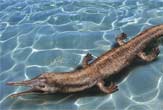Jurassic Crocodile Unearthed in Oregon

The fossil of an ancient amphibious reptile with a crocodile's body and a fish's tail has been unearthed in Oregon. Scientists believe the creature's remains were transported by geologic processes nearly 5,000 miles away from where it originally died more than 100 million years ago.
The new fossil is the oldest crocodilian ever unearthed in Oregon and one of the few to be unearthed on this side of the Pacific. The “hybrid” animal is thought to be a new species within the genus Thalattosuchia, a group of crocodilians living during the age of dinosaurs.
The reptile roamed a tropical environment in Asia about 142 to 208 million years ago. Called a Thalattosuchian, the amphibious creature [image] represents an early milestone in evolutionary history, marking a transition during which these reptiles moved from being semi-aquatic to wholly ocean species.
Rocky ride
Scientists uncovered the remains [image] of the six- to eight-foot-long reptile in Jurassic rock on private property in the Snowshoe Formation of the Izee Terrane, a rock formation in Oregon. They knew the croc came from Asia due to distinct anatomical features, such as the way its ribs were connected to the rest of its body.
The rock-entombed animal migrated eastward from perhaps Japan via continental drift, a theory of land movement in geological time, suggests William Orr, part of the fossil-discovery team and director of the Thomas Condon State Museum of Fossils at the University of Oregon.
During ancient times, the Pacific Ocean was much wider than it is today, and Orr suggests the rocky ride could have taken as long as 100 million years before reaching North America.
Sign up for the Live Science daily newsletter now
Get the world’s most fascinating discoveries delivered straight to your inbox.
“This idea is kind of profound, that you can move pieces of the Earth’s real estate about the globe,” Orr told LiveScience.
Into the ocean
Like modern-day crocodilians, the creature sported both land-lubbing and ocean-faring equipment. It had short, stubby legs, which the scientists say would have allowed it to creep easily along the ground and lay eggs.
But the amphibious Thalattosuchia was also at home in the water. With webbed feet and a fish’s tail, the reptile was likely a swift swimmer that could pulse through the water in search of aquatic prey.
“The thing that makes this creature unique is its tail,” Orr said. Unlike today’s reptiles, the creature had a shark-like tail, an indication of its ability to maintain itself in a marine environment.
“[The animal] was awfully close to being purely aquatic,” Orr said.
- Images: Dinosaur Fossils
- Vote: Avian Ancestors: Dinosaurs That Learned to Fly
- Top 10 Amazing Things You Didn’t Know About Animals
- Fins of Ancient Marine Reptile Like Fiberglass
- All About Dinosaurs
Jeanna Bryner is managing editor of Scientific American. Previously she was editor in chief of Live Science and, prior to that, an editor at Scholastic's Science World magazine. Bryner has an English degree from Salisbury University, a master's degree in biogeochemistry and environmental sciences from the University of Maryland and a graduate science journalism degree from New York University. She has worked as a biologist in Florida, where she monitored wetlands and did field surveys for endangered species, including the gorgeous Florida Scrub Jay. She also received an ocean sciences journalism fellowship from the Woods Hole Oceanographic Institution. She is a firm believer that science is for everyone and that just about everything can be viewed through the lens of science.









